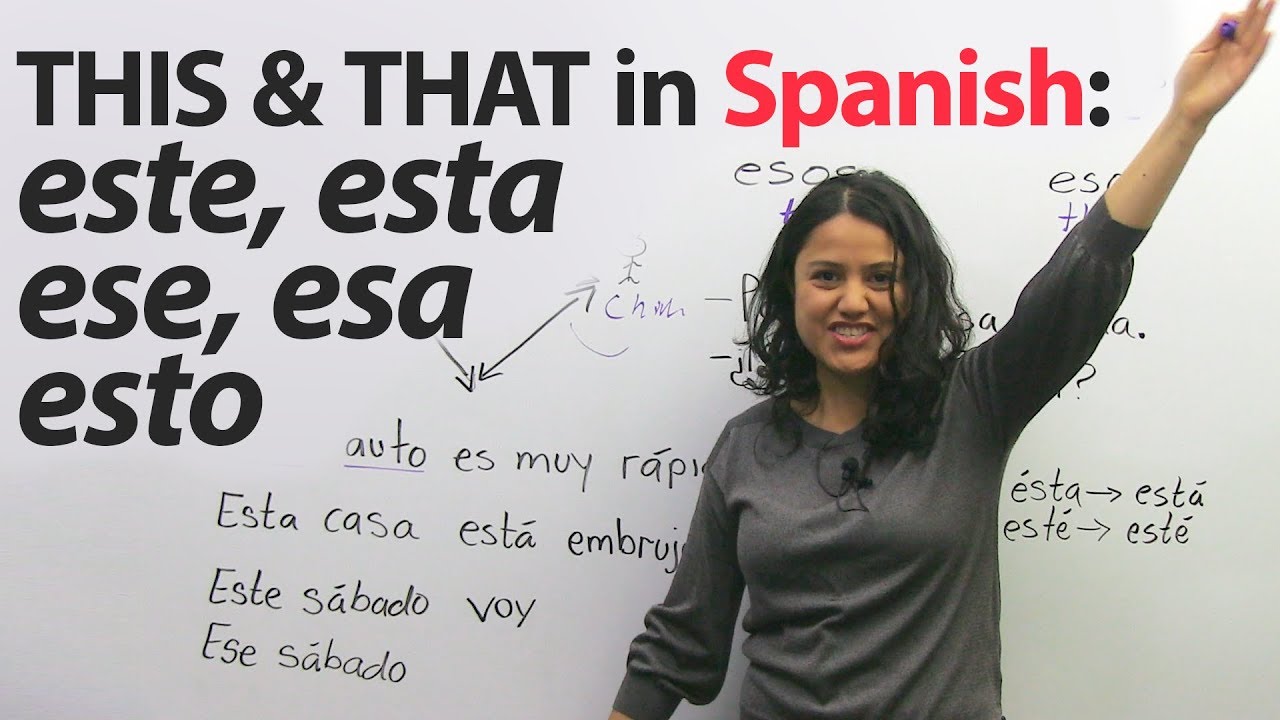
Are you grappling with the perplexing “este” and “esta” puzzle in Spanish? Fear not, for you are not alone in this linguistic labyrinth.
As a passionate learner, I understand the struggles of mastering the intricate nuances of grammar. But fret not, dear readers.
In this captivating blog post, we shall embark on an exhilarating expedition into the depths of “este” and “esta.” Though seemingly similar, these two words have distinct roles in Spanish.
Whether you find yourself at the beginning of your language journey or are a seasoned veteran seeking to refine your skills, comprehending when to employ “este” versus “esta” is vital for effective communication.
So buckle up and join me as we unravel the enigma behind these two cunning words.
Do you use Este or esta?
Contents
- 1 Do you use Este or esta?
- 2 When to Use Este and Esta in Spanish?
- 3 How to Use Este and Esta as Pronouns?
- 4 The Rules of Gender and Number Agreement for Este and Esta
- 5 How to Choose Between Este and Esta?
- 6 Examples of Este and Esta in Context
- 7 The Plural Forms of Este and Esta
- 8 Common Mistakes with Este and Esta
- 9 Tips for Using Este and Esta Correctly
- 10 Conclusion
Are you ready to delve into the fascinating world of Spanish grammar? Today, we will tackle a common question that often confuses Spanish learners: Do you use “este” or “esta”? Get ready to unlock the secret behind these two words and become a master of Spanish demonstrations.
Gender and Number Agreement:
In Spanish, “este” and “esta” are demonstrative adjectives that mean “this” in English. The key to using them correctly lies in understanding gender and number agreement. So, let’s break it down.
- Masculine Singular: When referring to a singular masculine noun close to the speaker, we use “este.” For example, “este libro” means “this book.” Here, the noun “libro” is masculine and singular.
- Feminine Singular: Conversely, when describing a singular feminine noun close to the speaker, we use “esta.” For instance, “esta silla” means “this chair.” In this case, “Silla” is feminine and singular.
- Masculine Plural: For multiple masculine objects near the speaker, we opt for “estos.” For example, “estos libros” translates to “these books.”
- Feminine Plural: When referring to multiple feminine objects close to the speaker, we choose “estas.” For instance, “estas sillas” means “these chairs.”
Proximity Matters:
In addition to gender and number agreement, Proximity plays a role in choosing between “este/esta” and their counterparts. Let’s see how this works:
- Close Proximity: When an object is near the speaker or us, we use the matching form of “este/esta.” For example, if you’re holding a book, you would say “este libro.”
- Distant Proximity: On the other hand, if an object is farther away or more distant from the speaker, we employ “ese/esa” (masculine/feminine singular) or “esos/esas” (masculine/feminine plural). For instance, if you’re pointing to a book across the room, you would say, “ese libro.”
Remember, the key is to consider gender and number agreement with the noun being modified. Additionally, think about Proximity when choosing between “este/esta” and “ese/esa.” Practice using these words in everyday conversations; soon, you’ll speak Spanish like a pro.
When to Use Este and Esta in Spanish?
If you’ve ever struggled with choosing between “este” and “esta” when trying to express “this” in Spanish, fear no more. In this blog post, we’ll unlock the secret behind this confusing choice and help you become a master of using these words correctly.
Understanding Gender and Number Agreement:
The key to correctly using “este” and “esta” lies in understanding gender and number agreement. In Spanish, nouns are either masculine or feminine and can be singular or plural. “Este” is used with masculine singular nouns, while “esta” is used with feminine singular nouns.
Examples:
- Este libro (this book): The word “libro” is masculine and singular.
- Esta mesa (this table): The word “mesa” is feminine and singular.
When it comes to plural nouns, both “este” and “esta” change to match the gender of the noun:
- Estos libros (these books): The word “libros” is masculine and plural.
- Estas mesas (these tables): The word “mesas” is feminine and plural.
Considering Proximity:
In addition to gender and number agreement, the Proximity of the object being referred to also determines whether to use “este” or “esta.” Use “este” when the object is closer to the speaker or the person being addressed. Use “esta” when the thing is closer to the person being talked about or referred to.
Context Matters:
Context also plays a role in determining whether to use “este” or “esta.” It can provide clues about the gender of the noun or indicate whether the object being referred to is close or far.
Practice Makes Perfect:
To become comfortable and familiar with “este” and “esta,” it’s important to practice using them in different contexts and with various nouns. This will help improve your Spanish speaking and writing skills, adding accuracy and precision to your language usage.
How to Use Este and Esta as Pronouns?
Are you ready to learn to use the Spanish pronouns “este” and “esta”? These special words are like little arrows that point to specific things. In this blog post, we will explore the differences between “este” and “esta” as pronouns and discover how they help us talk about objects in Spanish. So, let’s dive right in.
What are “este” and “esta”?:
“Este” and “esta” are pronouns in Spanish that replace nouns. They help us avoid repeating the same word over and over again. Think of them as shortcuts. But remember, they must agree with the gender and number of the noun they replace.
Masculine or Feminine?:
“Este” is used for masculine nouns, while “esta” is used for feminine nouns. For example, if you want to say, “I like this car,” you would say, “Me gusta este coche” because “coche” (car) is masculine. But if you want to say, “I like this house,” you would say, “Me gusta esta casa” because “casa” (house) is feminine.
Singular or Plural?:
Now, let’s talk about the number agreement. If you have only one object, use the singular forms of these pronouns. For example, if you want to say, “This book is mine,” you would say, “Este libro es mío.” But if you have more than one object, use the plural forms. If you want to say, “These books are mine,” you would say, “Estos libros son míos.”
Practice Makes Perfect:
Practice with different objects around you to become a pro at using these pronouns. Look at a pen and say, “Este bolígrafo es mío” (This pen is mine). Look at a chair and say, “Esta silla es cómoda” (This chair is comfortable). Remember to consider the gender and number of the nouns you replace.
Confidence is Key:
Using “este” and “esta” may feel tricky at first, but you’ll become more confident with practice. Listen to native Spanish speakers, watch movies or TV shows in Spanish, and avoid making mistakes. Remember, learning a new language is an adventure.
The Rules of Gender and Number Agreement for Este and Esta
Today, we will unravel the mysteries of gender and number agreement for the Spanish pronouns “este” and “esta.” These two words may seem simple at first glance, but their correct usage can be challenging. Fear not as we embark on this adventure together, armed with knowledge and determination.
Gender Agreement:
In Spanish, nouns are classified as either masculine or feminine. This classification directly affects which form of the pronoun to use. When referring to a masculine noun, we use “este.” For example, “este libro” means “this book.” On the other hand, when referring to a feminine noun, we use “esta.” For instance, “esta casa” means “this house.” It’s as simple as that.
Number Agreement:
Now that we have tackled gender agreement let’s move on to number agreement. Just like in English, Spanish nouns can be singular or plural. To match the number of the noun, we modify the pronouns accordingly. We use “este” or “esta” for singular nouns depending on gender. For example, “este coche” means “this car,” and “esta mesa” means “this table.”
When it comes to plural nouns, things get more interesting. For plural masculine nouns, we use “estos,” which translates to “these” in English. For instance, “estos libros” means “these books.” Conversely, for plural feminine nouns, we use “estas,” meaning “these.” For example, “estas casas” means “these houses.”
In summary, when using the Spanish pronouns “este” and “esta,” remember these key points:
- Use “este” for singular masculine nouns and “esta” for singular feminine nouns.
- For plural masculine nouns, use “estos,” and for plural feminine nouns, use “estas.”
How to Choose Between Este and Esta?
Are you ready to dive into the fascinating world of Spanish grammar? Today, we will unravel the mystery behind choosing between “este” and “esta” when referring to specific objects or things. So, grab your sombrero, and let’s get started.
Understanding Gender Agreement:
In Spanish, nouns have a gender, either masculine or feminine. And just like peanut butter and jelly, adjectives must agree in gender with the nouns they modify. When using “este” or “esta,” it’s essential to identify the gender of the noun.
If the noun is masculine, use “este,” like “este libro” (this book). But if it’s feminine, go for “esta,” as in “esta casa” (this house).
It’s Not About Physical Appearance:
Refrain from judging a noun by its cover. The gender of a noun is not determined by its physical characteristics but rather by its grammatical gender. For example, even though a car may seem masculine in English, in Spanish, it is feminine. So, say “esta carro” (this car) instead of “este carro.”
Singular or Plural?
In Spanish, nouns can be singular or plural. But fear not. The “este” and “esta” rules also apply to plurals. For singular nouns, use the corresponding form of “este” or “esta.” When talking about multiple objects, use “estos” for masculine nouns (“estos libros” – these books) and “estas” for feminine nouns (“estas casas” – these houses).
Pronoun Power:
Did you know that “este” and “esta” can also be used as pronouns? Instead of saying “quiero este libro” (I want this book), you can say “lo quiero” (I like it). Remember, the pronoun form must still agree with the gender and number of the noun it replaces.
Practice Makes Perfect:
Language learning is like riding a bike – practice makes perfect. Try incorporating “este” and “esta” into your daily conversations. Watch Spanish movies, listen to music, or chat with native speakers. The more you practice, the more natural it will feel.
You’ve mastered the art of choosing between “este” and “esta” in Spanish. By understanding gender agreement, remembering it’s not about physical appearance, considering singular or plural nouns, and even using them as pronouns, you’re well on your way to becoming a Spanish language superstar.
Examples of Este and Esta in Context
Today’s blog post will tackle the ever-confusing world of “este” and “esta” in Spanish. These two words can make a big difference in your communication, so let’s dive right in.
- Demonstrating Proximity: “Este” and “esta” are used to indicate Proximity or location. If you’re talking about something close to you, use “este” for masculine nouns and “esta” for feminine nouns. For example, if you’re holding a book and want to say “this book,” you would say “este libro” (masculine) or “esta libro” (feminine).
- Describing Time: Not only do “este” and “esta” help with physical Proximity, but they can also describe time. When discussing the current day or month, use “este” for masculine nouns and “esta” for feminine nouns. So if it’s Monday, you’d say “este lunes” (this Monday), or if it’s January, you’d say “esta enero” (this January).
- Expressing Emotions or Opinions: You can also use “este” and “esta” when expressing emotions or opinions about something. Just remember to keep the gender agreement with the noun being referred to. For example, if you want to say “this beautiful view,” you would say “esta hermosa vista.”
- Differentiating between “This” and “That”: It’s important to note that while both “este” and “esta” can be translated as “this,” they are used differently depending on the distance between the speaker and the object. If the object is close to you, use “este/esta.” If it’s further away but still visible, use “ese/esa.” And if it’s out of sight or far from you and the listener, use “aquel/aquella.” For example, if you want to say “that car” to a car near you, you would say “este coche.” But if the car is further away from you and the listener, you would say, “ese coche.”
- Demonstrative Pronouns: Finally, “este” and “esta” can also be used as pronouns to replace a noun in a sentence. They agree on gender and number, with the noun being replaced. So instead of saying, “I like this shirt,” you can say, “Me gusta esta” (referring to the shirt).
The Plural Forms of Este and Esta
As demonstrative adjectives, these words play a crucial role in indicating specific nouns. Understanding their gender agreement and usage nuances will significantly enhance your Spanish language skills.
Este and Esta – Singular Forms:
- “Este” is the masculine singular form used for a singular masculine noun near the speaker. Example: “Este libro” (This book).
- “Esta” is the feminine singular form employed for a singular feminine noun close to the speaker. Example: “Esta casa” (This house).
Forming the Plural:
- To create the plural forms of “este” and “esta,” simply add an -s at the end.
- “Estos” is the plural form of “este,” referring to multiple masculine nouns near the speaker.
- “Estas” is the plural form of “esta,” indicating multiple feminine nouns near the speaker.
Matching Gender and Number:
- It is crucial to match the gender and number of the adjective with the noun it modifies.
Examples:
- Masculine plural: “Estos libros” (These books).
- Feminine plural: “Estas casas” (These houses).
Proximity Considerations:
- The Proximity of the nouns to the speaker influences singular or plural usage.
- Singular forms are typically used for closer nouns, while plural forms are more suitable for those farther away.
Mixed Gender Nouns:
- When dealing with a mix of masculine and feminine nouns, use the masculine plural form.
- Example: If you have both masculine and feminine books, use “estos libros” (These books).
You have successfully journeyed through the plural forms of “este” and “esta” in Spanish. You can convey precise meaning and enhance your communication ability by mastering these distinctions. Practice using them in different contexts to solidify your understanding. ¡Buena suerte. (Good luck.)
Common Mistakes with Este and Esta
Mastering the usage of “este” and “esta” in Spanish is crucial for effective communication. In English, these demonstrative adjectives, meaning “this,” can be tricky due to their gender and number agreements. This blog post will explore the common mistakes made when using “este” and “esta” and provide valuable insights to avoid these errors.
Mistake #1: Ignoring Gender Agreement
The first mistake learners often make is not considering the gender of the noun when using “este” or “esta.” Remember, “este” is for singular masculine nouns, while “esta” is for singular feminine nouns. For example, saying “este casa” instead of “esta casa” is incorrect.
Mistake #2: Misusing with Plural Nouns
Another common mistake is using “este” or “esta” with plural nouns. Instead, we use the plural forms “estos” (masculine) or “estas” (feminine). For instance, say “estos libros” (these books) or “estas casas” (these houses) instead of using singular forms.
Mistake #3: Neglecting Proximity and Context
Choosing between “este/esta” and other demonstrative adjectives such as “ese/esa” or “aquel/aquella” depends on Proximity. Use the singular form when the noun is close to the speaker and the plural form when it’s far. Context also plays a role, so pay attention to whether you are referring to something near or far from the speaker and listener.
Mistake #4: Exception with Stressed ‘A’ Sound Nouns
When using these demonstrative adjectives with nouns that start with a stressed ‘a’ sound, such as “agua” (water) or “amiga” (friend), use the masculine forms instead of the feminine ones. For example, say “este agua” (this water) instead of “esta agua.”
Tips for Using Este and Esta Correctly
As a Spanish language learner, it is crucial to understand the correct usage of “este” and “esta,” which are Spanish demonstrative adjectives that mean “this” in English. In this blog post, we will delve into these two words’ gender and number agreement, Proximity, and context, and provide tips for using them correctly in conversations and writing.
Gender and Number Agreement:
To properly use “este” and “esta,” you must consider the gender and number of nouns they modify. “Este” is used for masculine singular nouns, while “esta” is used for feminine singular nouns. For example, “este libro” (this book) and “esta casa” (this house).
Proximity Matters:
The choice between “este” and “esta” depends on the object’s Proximity. Use “este” when referring to something close to the speaker and “esta” when referring to something close to the listener. For example, “este coche” (this car) if you are near the vehicle or “esta silla” (this chair) if you are close to a chair.
Consider the Context:
The context plays a vital role in selecting between “este” and “esta.” If a specific item has been previously mentioned or is known to both the speaker and listener, use “este” or “esta” accordingly. For instance, when discussing a movie, I already said, “Me gusta esta película” (I like this movie).
Pronoun Usage:
Remember that “este” and “esta” can also be used as pronouns, replacing a noun in a sentence. This allows for more concise expressions. For example, instead of saying “quiero este libro” (I want this book), you can say “lo quiero” (I like it), with “lo” being the pronoun form of “este.”
Practice Makes Perfect:
To master the usage of “este” and “esta,” practice is essential. Use these words in various contexts and sentences to become more familiar with their usage. The more you practice, the more confident you will become in choosing the correct word.
Conclusion
The question of whether to use “este” or “esta” can be a source of confusion for many Spanish learners. However, you can confidently navigate this grammatical challenge with a clear understanding of their usage.
Let’s start by clarifying the difference between the two words. “Este” is a masculine singular demonstrative adjective, while “esta” is its feminine superior counterpart. They both mean “this” in English and indicate Proximity or point out something specific.
When deciding whether to use “este” or “esta,” you need to consider the gender and number of the noun it modifies. For example, if you’re referring to a masculine singular noun like “libro” (book), you would use “este libro.” On the other hand, if you’re talking about a feminine singular noun like “casa” (house), you would say “esta casa.”
It’s important to note that these demonstrative adjectives change depending on the gender and number of the noun they modify. For plural nouns, you would use “estos” for masculine and “estas” for feminine. For example, if you’re referring to multiple books, you would say “estos libros,” for numerous houses, it would be “estas casas.”
Mastering the correct usage of “este” and “esta” takes practice and familiarity with gender agreement in Spanish grammar. By paying attention to the gender and number of the nouns you’re referring to, you can choose between these two words accurately.
In conclusion, understanding when to use “este” or “esta” is essential for effective communication in Spanish. With practice and attention to detail, you’ll become more confident using these demonstrative adjectives correctly.


